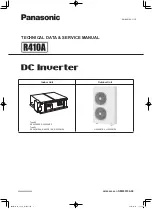
Table
5
‐
1
Troubleshooting
Reference
Problem
Possible
Cause
Solution
Low
output
voltage
(96
V
AC–104
V
AC)
You
are
using
a
voltmeter
that
cannot
accurately
read
the
RMS
voltage
of
a
modified
sine
wave.
Low
input
voltage
and
the
load
is
close
to
maximum
allowable
power.
Use
a
true
RMS
reading
voltmeter.
Check
the
connections
and
cable
to
see
if
the
battery
is
fully
charged.
Recharge
the
battery
if
it
is
low.
Reduce
the
load.
No
output
voltage
Both
the
Power
light
and
Fault
light
are
off.
The
inverter
is
off.
No
power
to
the
inverter.
The
inverter
could
have
been
connected
with
reverse
DC
input
polarity.
Turn
the
inverter
on.
Check
the
wiring
to
the
inverter
and
to
the
Disconnect/Battery
Selector
switch.
The
inverter
has
probably
been
damaged.
Return
the
unit.
Damage
caused
by
reverse
polarity
is
not
covered
by
the
warranty.
Information
for
returning
the
inverter
is
provided
in
the
Warranty
section
Problem
Possible
Cause
Solution
No
output
voltage.
Fault
light
is
on
Low
input
voltage
High
input
voltage
Thermal
shutdown
Unit
overload
Output
is
short
circuited.
Recharge
the
battery;
check
the
connections
and
cable.
Make
sure
the
Mobile
Digital
Power
Inverter
is
connected
to
a
12
V
battery
check
the
voltage
regulation
of
the
charging
system.
Allow
the
unit
to
cool
off.
Reduce
the
load
if
continuous
operation
is
required.
Improve
ventilation.
Make
sure
the
inverter’s
ventilation
openings
are
not
obstructed.
Reduce
the
ambient
temperature.
Reduce
the
load.
Make
sure
the
load
does
not
exceed
the
Mobile
Digital
Power
Inverter’s
output
rating.
Remove
the
short
circuit.
Low
battery
alarm
stays
on.
Poor
DC
wiring;
poor
battery
condition
Use
proper
cable
size
and
lengths
and
make
solid
connections.
Charge
the
battery.
Install
a
new
battery
Unit
does
not
restart
after
a
fault
condition
Unit
is
restarted
too
soon.
Turn
off
the
unit
then
wait
about
3
to
5
seconds
before
turning
it
on
again
13




































